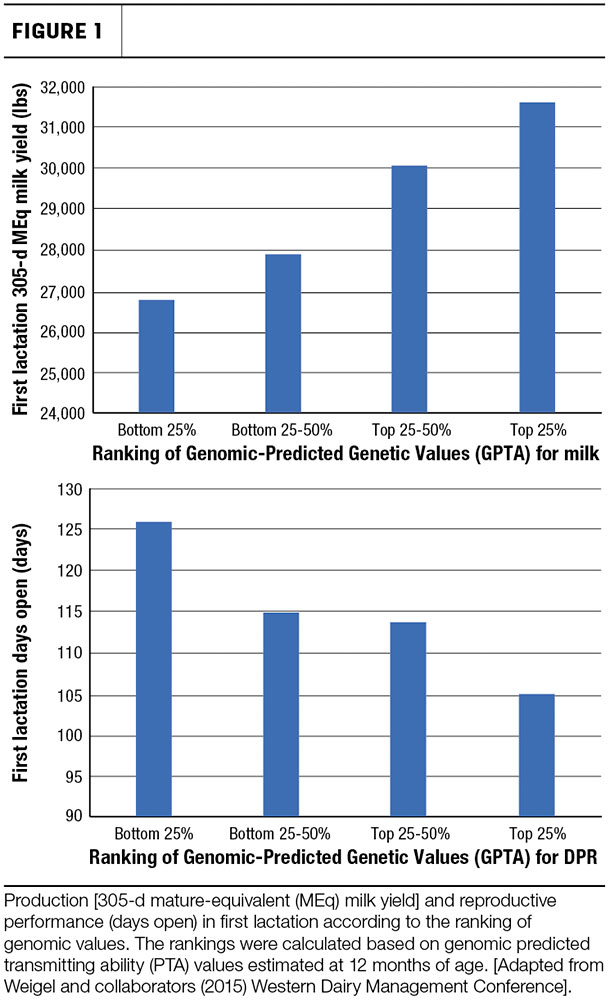The selection of replacement heifers in commercial dairy farms has been traditionally characterized by very low intensity of selection, because in general farmers retain nearly every heifer calf as a future herd replacement. However, recent improvements in herd management have reduced involuntary culling rates and improved reproductive efficiency, which has led to the ability to produce excess heifers.
Additionally, the use of sexed semen can also generate a considerable surplus of heifer calves. In this context, the selection of replacement heifers is feasible. The key question here is: How do we select the necessary replacements? In other words, how can we identify superior or inferior heifer calves accurately? The use of genomic testing, namely the use of genetic markers across the genome to predict breeding values, allows us to identify and select heifers at an early age.
What are the advantages of using genomics for selecting heifer calves? The key point is to try to estimate as precisely as possible the genetic merit of a heifer at a young age. In the absence of genomic information, the selection or culling of a given heifer calf is based on the average genetic merit of her parents. The reliability of this information typically ranges from 0 when we do not know the parents to 0.4 if we have access to complete pedigree information.
Now, if we use genomic testing, then the reliability of the genomic-predicted genetic merit of the heifer calf ranges from 0.55 to 0.75 depending on the trait of interest and the amount of pedigree data available. Interestingly, this genomic prediction early in life is generally more reliable than the traditional predicted transmitting ability (PTA) estimated using several lactation records on both the cow and her daughters. Therefore, genomic testing allows us to make accurate selection (culling) decisions at an early age, and these decisions are more reliable than those that can be achieved using pedigree information alone.
Probably one of the key points regarding the use of genomics for selecting herd replacements is to demonstrate that the results of the genomic testing are highly correlated with future phenotypic performance. Recently, colleagues at the University of Wisconsin – Madison compared early genomic predictions with subsequent production and reproduction performance in the first lactation of Holstein cows (see Figure 1). Cows were ranked based on their own genomic PTA values (predicted at 12 months of age), and then these alternative quartile rankings (from the top 25 percent to the bottom 25 percent) were compared with the actual phenotypic performance in first lactation.

If there is an association between genomic testing and future performance, then we expect that the best heifers in terms of genomic values show greater phenotypic records. Indeed, for milk yield, the observed difference between the top and the bottom quartiles was equal to 4,800 pounds (top chart in Figure 1). For female fertility, the actual difference in days open between those heifers classified as the top 25 percent and those classified as the bottom 25 percent was equal to 21 days (bottom chart in Figure 1). Therefore, these findings show that early genomic predictions (performed on calves or yearling heifers) can be effectively used as predictors of future performance. In other words, genomic testing can be used to make accurate selection decisions at a young age.
Genomic information on individual animals can be used to reduce feed costs and improve the genetic level of herd replacements. Indeed, the identification of genetically inferior heifer calves allows early culling of these animals, significantly reducing the cost of raising replacements.
Alternatively, these genetically inferior heifers can be inseminated with beef semen to produce high-value crossbred beef calves. Note that these cows inseminated with beef semen are in fact removed as parents of the next generation.
On the other hand, the identification of superior heifers through genomics can be combined with the use of advanced reproductive technologies to rapidly propagate these animals and generate superior replacements. For instance, high-genetic-merit heifers can be used as donors in either an in vitro fertilization program or an embryo transfer program. Instead, these superior heifers can be inseminated using sexed semen from top sires.
It is worth noting that genotyping replacement heifers has extra benefits other than making proper selection and mating decisions, including parentage verification, controlling inbreeding and avoiding the spread of genetic disorders through genomic-enhanced matings. Arguably, these benefits add value to genomic testing.
Overall, genomics has revolutionized dairy cattle breeding. Nowadays, dairy farmers can use this technology to support more accurate selection or culling replacement decisions. Those producers who combine genomic testing with other management decisions, such as early culling to reduce feed cost or the use of advanced reproductive technologies to rapidly propagate the best females in the herd, will capture the greatest benefits of this technology. ![]()
Francisco Peñagaricano is an assistant professor of dairy cattle genetics and genomics in the University of Florida Department of Animal Sciences. Email Francisco Peñagaricano.







